The Value of Ventilation in Residential Plumbing Systems
The Value of Ventilation in Residential Plumbing Systems
Blog Article
Each person is bound to have their personal theory in relation to The Upsides of Proper Ventilation in Plumbing Design.

Correct ventilation in plumbing systems is commonly ignored, yet it is crucial for keeping the capability and safety and security of your home's plumbing. Ventilation assists control atmospheric pressure, avoid the build-up of damaging gases, and make certain the effective elimination of waste. In this overview, we will explore the relevance of appropriate plumbing ventilation, exactly how it functions, and the advantages it gives your pipes system.
Understanding Ventilation in Plumbing
Ventilation in pipes describes the network of pipes that enable air to flow with the drainage system. These vents serve several objectives, consisting of regulating air pressure within the pipes, protecting against sewer gases from entering the home, and assisting in the smooth circulation of wastewater.
How Air Flow Functions in Pipes Systems
Air Pressure Regulation
Proper air flow preserves balanced air pressure within the pipes system. When water streams via pipes, it displaces air. Without adequate ventilation, this variation can create negative pressure, resulting in reduce drains or siphoning of water from traps, which can create unpleasant smells to permeate into the home.
Stopping Drain Gas Build-up
One of the most critical functions of pipes vents is to avoid drain gases, such as methane and hydrogen sulfide, from gathering within the home. These gases can present major health threats and are very flammable. Vent pipes permit these gases to escape safely outdoors.
Assisting in Waste Removal
Air flow aids in the efficient elimination of wastewater by preventing airlocks in the drainage system. When air can move easily through the vents, it permits water and waste to stream smoothly via the pipelines, reducing the danger of obstructions and backups.
Sorts Of Pipes Vents
Main Stack Vent
The main pile air vent, also referred to as the vent pile, is the key vent in a plumbing system. It prolongs from the primary drainpipe line up through the roofing, allowing gases to run away and fresh air to enter the system.
Branch Vent
Branch vents link to the major pile air vent and serve private components, such as sinks, toilets, and showers. These vents make sure that each fixture has appropriate air flow to function appropriately.
Air Admission Valve (AAV).
An Air Admission Shutoff (AAV) is a one-way shutoff that enables air to go into the pipes system without the need for a typical air vent pipeline prolonging through the roofing. AAVs are frequently made use of in restorations or areas where setting up a conventional air vent is not practical.
Signs of Poor Ventilation in Plumbing.
Slow Draining Fixtures.
If your sinks, bathtubs, or bathrooms are draining pipes gradually, it could be a sign of inadequate air flow. Insufficient air flow can develop a vacuum result, making it tough for water to drain pipes appropriately.
Gurgling Seems.
Gurgling audios coming from drains pipes are typically a result of air being drawn through water traps as a result of negative stress in the pipelines. This is a clear sign of not enough air flow.
Unpleasant Smells.
Sewage system smells inside your home are a warning that your pipes system is not properly ventilated. This could indicate that drain gases are not being adequately vented outside, resulting in potentially hazardous conditions.
Usual Ventilation Blunders.
Poor Vent Sizing.
Utilizing undersized vent pipelines can cause bad air circulation and pressure inequalities in the system. It's vital to utilize vents that meet the specific requirements of your pipes system.
Improper Vent Positioning.
Placing vents also much from the fixtures they serve can lower their efficiency. Correct positioning makes certain that air can stream easily and successfully via the system.
Ignoring Code Demands.
Building ordinance offer particular standards for plumbing ventilation. Ignoring these codes can cause a system that stops working to function correctly and may result in costly fixings or health hazards.
Benefits of Proper Ventilation.
Boosted System Performance.
Properly ventilated plumbing systems operate much more effectively, with fewer blockages, faster draining, and less pressure on the pipelines. This performance prolongs the lifespan of the plumbing system.
Improved Air Quality.
By protecting against sewer gases from entering your home, proper ventilation contributes to much better interior air top quality, making your living environment healthier and a lot more comfy.
Stopping Water Damage.
Appropriate ventilation helps avoid water from being siphoned out of traps, which can cause sewer gases entering the home and causing water damages gradually.
Actions to Make Sure Proper Ventilation.
Consulting Plumbing Codes.
Constantly consult neighborhood pipes codes when creating or customizing your pipes system. These codes provide the necessary guidelines for correct airing vent and ensure your system satisfies security requirements.
Routine Examination and Maintenance.
Regular evaluations can assist determine prospective ventilation problems before they end up being major problems. Maintenance tasks, such as cleaning up vent pipes and checking for clogs, are vital for keeping the system in good working order.
Expert Installment.
For brand-new setups or major alterations, it's smart to work with a specialist plumbing technician. They have the expertise to make sure the air flow system is correctly developed and installed according to code.
Conclusion.
Appropriate air flow is a crucial part of any type of pipes system, making sure that it functions effectively and securely. By comprehending the value of air flow, recognizing the indications of inadequate ventilation, and taking steps to preserve your system, you can protect against costly concerns and shield your home's air quality.
4 Things You Should Know About Your Plumbing Vents
What Plumbing Vents Are
Also called a vent stack, a plumbing vent is a vertical pipe attached to your drain line that runs through your roof. The plumbing vent pipe, or plumbing air vent, removes gas and odors from your plumbing system and allows fresh air to enter the pipes, helping the water to flow out of the drain pipes.
What Plumbing Vents Do
Plumbing vents have two basic functions. One of which is to allow unpleasant smelling wastewater and sewer gasses to escape your plumbing system instead of entering your home. Plumbing vent pipes are typically located on roofs, away from windows, to ensure the fumes exit the home completely.
The other function of the plumbing vent is to move fresh air into your plumbing system. This helps move water through every plumbing fixture in your house, like toilets and sink drains. Think of the way in which you need to let a little air into the bottle as you pour soda in order to make the drink flow smoothly.
Different Types of Plumbing Vents
True vent: This is the most common vent option. In simplest terms, a true vent is a vertical pipe attached to your drain line that exits through the roof. They often function as the main vent that other fixtures can connect to. Re-vent pipe or auxiliary vent: Attached to the drain line near specific plumbing fixtures, re-vent pipes run up and over to connect to the main vent. Common vent: Two plumbing fixtures installed on opposite sides of a wall are typically tied into the vent stack using something known as a sanitary cross. Wet vent: This venting option operates as a drain pipe and a vent at the same time. Wet vent drainage systems drain water from one fixture while venting the air from another. Although they’ve been used for over 100 years, wet vent systems have only recently been added to the plumbing code in many areas. If you’re planning on installing one in a bathroom remodel, make sure you check your local code prior to construction. Loop vent: For free-standing fixtures like kitchen island sinks, loop vents are ideal. These vent pipes run under the floor, rise from the P-trap, and create a loop inside the cabinet sink. Air admittance valve: An AAV is a one-way mechanical valve typically installed at the site of the plumbing fixture. AAVs allow venting to occur without having to tie into a larger venting system. They’re ideal for venting fixtures where you aren’t able to easily connect to an existing vent system. Common Plumbing Vent Issues
Although vent pipes typically don’t have water flowing through them, they’re still subject to many typical plumbing issues. For example, clogs are one of the most common problems associated with sewer vent pipes. If your vent pipe gets clogged, all of your plumbing fixtures tied into the vent stack will be affected.
A sink with a slow drain that bubbles and gurgles or a strong sewage smell around your toilet are both indicators that your toilet vent pipe is clogged. Because most vent pipes exit through the roof, old leaves, twigs or even a bird’s nest could be clogging the pipe.
Clogs in your vent pipe system cause a buildup of negative pressure, meaning that water won’t be able to flow out of your home very well. It’s similar to putting your finger over the opening of a straw to trap water inside. When you remove your finger, the water is able to flow out of the straw.
If you suspect you have any blockage in your vent, make sure you have a professional come examine the situation. Left unchecked, a blocked air vent can lead to other costly repairs, like leaks and sediment buildup.
Under Pressure
Pipe vents are essential aspects of a home’s plumbing system. Owning a home means learning about all sorts of things you never put much thought into before. But by understanding as much as you can about the important systems of your home, you can keep those budgets intact and those anxiety levels low.
https://www.homeserve.com/en-us/blog/home-improvement/plumbing-vents/

We were made aware of that editorial about through an acquaintance on another web address. Sharing is nice. You never know, you may very well be helping someone out. Thanks a lot for being here. Revisit us soon.
Click Here Report this page